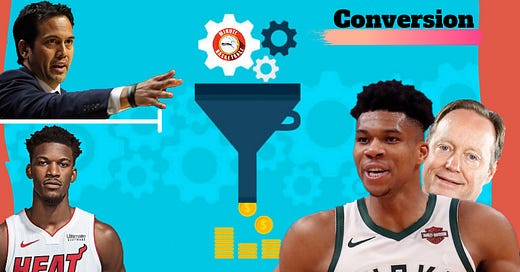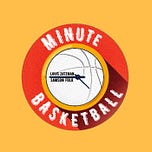
There are lots of different kinds of magic, but alchemy has to be right at the top of the least comprehensible forms of wizardry. It’s magic to be able to convert one thing into another. A substance into another, a feeling, a memory. It’s always been magic.
To turn thought into action.
Last week showed how incredible this collective group of NBA players is. On the heels of the murder of George Floyd, the players came to Orlando, aceded to the bubble on the premise that it would help inspire change, help convert our society into something better. They wore Black Lives Matter shirts, masks, pins, shoes, gave media appearances behind Black Lives Matter backdrops. They tried to keep the conversation going. Then Jacob Blake was almost murdered, and players felt like they hadn’t accomplished very much at all. A short wildcat strike ensued as, likely George Hill, then the Milwaukee Bucks, then the other teams in the league refused to play. Soon, team owners gave some political concessions and the players returned to work.
Partially as a cause, and partially as an effect, NBA players are leaders of the social justice movement. They are currently two things at once. They play games, care desperately, and then have to shower, dress, and face the camera to talk about social justice and Black Lives Matter. Whether they won or lost. It’s difficult compartmentalization, but it surely doesn’t mean we should blend the lines.
Or, on the smaller scale, the basketball scale, to convert an advantage into points. What does it mean to be a team that can change? Or the opposite, a team that is always itself, no matter what, for better or for worse?
NBA players have held those two tensions inside themselves, basketball and life, for a long time, longer than the duration of this bubble. They build schools and community centers, funding them with their basketball paychecks. They’ve always known which matters more. This week, we’re trying to hold those two tensions inside one newsletter. What can convert, what should convert, and what shouldn’t. This week in Minute Basketball: Conversion.
Looking Back - Zatzman
Inconvertible
Like lead into gold, some things should not be made the same. Like social justice and basketball. There’s no ratio at which they convert, no direct comparison to be made. And writers who have tried to conflate the two have been, at best, exploitative.
Right now, NBA players are two things at once. Those edges can’t be blurred, lines can’t be crossed. The picture is messier when you try to superimpose one slide on the other.
NBA players are allowed to hold that tension inside of them, painful though it may be, anachronistic, bizarre, innovative. Allowed is the wrong word. They deserve praise for it. But writers are not allowed to pretend that the dual motivations of NBA players in the bubble -- winning basketball games and inspiring meaningful social change -- don’t both exist, or can be merged. Carrying the burden of inspiring change does not make a team’s victory more inspiring, does not make the Lakers’ emotional burden unrivaled, another angle of their basketball dominance. Re-purposing, converting the tragic death of Kobe Bryant into a for-sale narrative of the current Lakers’ championship hunt is ghoulish.
Asking questions to prompt emotional interviews -- why is this personal to you, how are you feeling, walk me through your emotions -- is a form of exploitation, certainly. That doesn’t necessarily make it wrong, particularly if players want to broadcast their emotions to the world. Want that to be an avenue of the fight for social justice. But a camera following a crying Jamal Murray off the court, through the hallway: that is the raw conversion of tears to cash.
It’s easy for players to recognize that exploitation. Fred VanVleet turned the question around, recognized that “[players] are the ones always with the microphones in our face… At what point do we not have to speak about it anymore? Are we going to hold everybody accountable, or are we just going to put the spotlight on black people?”
And that’s why NBA players’ burden of inspiring change is not self-imposed. They’re asked daily how they feel about George Floyd and Jacob Blake and Breonna Taylor and a thousand others, how they make sense of it, what it means to them. That converts tragedy to responsibility. And to their credit, they’ve taken that responsibility and run with it, forced real change. George Hill, Jaylen Brown, VanVleet are all inspiring. But they shouldn’t be tasked with the job in the first place. And circling that task, that burden back to basketball, making it one more narrative in the greatness of the Lakers or Jamal Murray or any team or player is gross.
There’s an indirect line between social justice and basketball, sure. The same individuals are community organizers, wealthy black men, and elite athletes. But converting one to the other is simplistic and flat-out wrong. Lead is not gold, can’t be made into it. Social justice is not basketball and most of all can’t be made to serve it for the purposes of content. It can be uncomfortable for writers to focus on basketball and social justice separately. We are out of our depths, our fields of specialization. But converting players and their actions into something that is more comfortable for us, easier and more profitable for our jobs, is an incorrect use of the magic of conversion. Some things can and should be different.
Looking Ahead - Folk
Converting and Converting
1: There’s an almost infinite amount of advantages (ranging from miniscule to massive) that can be gained on a basketball court.
2: Some advantages are so massive, that they are unilaterally hunted by every single NBA team. Length, and shooting ability (I guess the Knicks don’t count hehe) for example.
3. Creating advantages, and converting on advantages created are two different things.
The Miami Heat and the Milwaukee Bucks are diametrically opposed in basketball. The Heat, converting their roster into whatever it needs to be in the moment. Jimmy Butler and Bam Adebayo assume roles that are atypical but advantageous at the drop of a hat. In Miami they’ve collected a hodgepodge of talent that is both ill-fitting and wonderfully coalesced. They’re intelligent and changeable.
Milwaukee maximizes the advantages that are necessitated by Giannis Antetokounmpo’s presence on their squad. He is the central force on both ends of the floor, one of the most impressive players we’ve seen in years, and a battering ram on the way to the bucket. The team is built to accentuate those skills in a specific way, and they’re hard pressed to move from that position. That fortitude and belief in what they’re doing has led to historically great regular seasons, wherein teams rarely stray from their base packages and the Bucks power their way through unimaginative regular season basketball with their dominant and regimented style.
I think that’s what makes this series between the two teams one of the most interesting we’ll see in the playoffs. The Heat, inventive and filled with effort, wore a lot of different hats this season in an attempt to win as many games as possible. Typically, changeability is a good thing in the playoffs, especially when it comes with a high ceiling. Against the Bucks we’ll get to see how high the ceiling really is for the Heat and whether or not the advantages they create are only good enough to outclass a certain level of teams. 2 games up, so far. Can two malleable All-Stars + some specialists take down the league’s MVP, DPOY, and a cache of complementary pieces? That was the case in Game 1 & 2. Butler assumed the role of scorer supreme to close out the Bucks. Antetokounmpo and his teammates were hapless against the Heat’s intelligent defense late, and Butler’s incredible close to the game left the #1 seed in the dust.
Despite the rickety start to the playoffs for the Bucks, they are still very much a contender. An idea has taken hold in the NBA that they are close to a pseudo-contender rather than a full fledged one. The critiques are fair, because they highlight Eric Bledsoe’s offensive shortcomings, Malcolm Brogdon’s departure for Indiana (who is very good), and Mike Budenholzer’s shocking lack of prowess as an in-series coach. While Antetokounmpo is a world ending presence on the court, he doesn’t possess the type of game that is typically advantageous in the pressure cooker of clutch time. The Raptors preyed on the Bucks’ linear play last year, and their historically great and adaptive defense outfoxed the Eastern Conference’s best team. However (comma) they also had Kawhi Leonard, who was the NBA’s very best player in the postseason last year.
The level of basketball needed to beat these Bucks should be really high. And for the Heat to continue punching up against them successfully, they’ll need several things to go right, and often.
Adebayo and Duncan Robinson form what might be the NBA’s most potent dribble hand-off game. Adebayo’s quick twitch athleticism and body carved from granite operates as not only a great means of conveyance to the rim if teams overplay Robinson, but a rock-steady screen to shake his partner loose as well. Of course, the Bucks play drop defense and Bledsoe, Divincenzo, and Matthews all chase over the top exceptionally well, so Robinson might be squeezed into the middle of the court. I’m most interested to see how high Lopez plays on the ‘DHO’ actions. If Lopez drops low, Adebayo should be able to free Robinson up a little more. If Lopez plays really high, Adebayo might be able to scoop to the rim on occasion.
The Heat averaged 33 3-point attempts per game in the first round, and hit 39-percent of them. Very good. Those numbers track pretty well with what they did during the regular season, and they highlight another possible (perhaps certain?) advantage for the Heat. The Heat can punish the Bucks' proclivity towards allowing 3-point shots in a way that many other teams can’t, and they’ll be looking to attack them with a flurry of shots over the course of this series the same way the Magic did in Game 1. It remains to be seen if the Bucks can direct the surplus of 3-point looks to shooters like Kendrick Nunn, Jae Crowder (despite a good game 1), and Andre Iguodala, rather than Robinson, Tyler Herro, and Goran Dragic. The distribution of 3-point shots looms large in games 3-7.
Lastly, and despite game 1 indicating otherwise, the Heat probably won’t have the best player in this series, but if things break correctly, they can have #2 and #3. Butler has been trying to game the system from the outset. His incredibly disruptive brand of basketball that puts bigs in foul trouble, escorts him to the free throw line at an absurd rate, and allows him to play-make remarkably well from the middle of the floor, can quite conceivably outdo what Khris Middleton is bringing to the floor. Adebayo is still in the process of trying to figure out how to properly utilize all of his talents on offense and in what order, but his defense is for real. He’s strong, mobile, and intelligent. The Heat didn’t put Adebayo on Antetokounmpo to start, because Lopez is a very capable post-bully, but he’s always floating around his vicinity.
Stan Van Gundy’s “FORM A FUCKING WALL!” Comes to mind, of course.
Basically, the series comes down to each team's ability to emulate the other. The Bucks have been told (through cupped hands) to adjust and stop playing some version of an NBA team that will ideally succumb to their foolproof gameplan, and instead match up with the team in front of them. The Heat, needing to remain changeable, but steal away some of the gobsmacking efficiency that the Bucks are known for.
Right now, the Heat are converting and converting. Successful conversion, or something like that.
Game on, and god speed.
















Share this post